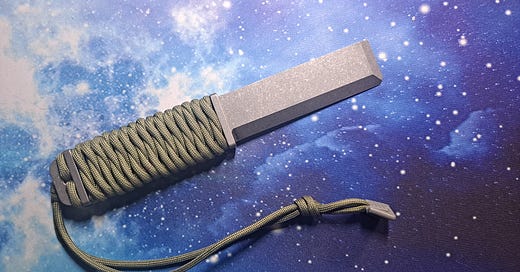Why do paracord shoelaces irk me so?
The basic idea of a high strength cordage, that’s lightweight, comes in dozens or colors and patterns, and even added threads of fishing line, sewing thread, snare wire, jute twine for “survival” cordage, is a great concept, but not well thought out.
1. What is the purpose of “survival” cordage?
The short answer, is to survive, sorta. Survival cord has quite a few opportunities to be useful. Typical survival cordage contains fishing line to aid in fishing. Jute twine, sometimes waxed for water protection is used to create fire as its easy to ignite. Cotton thread for sewing, gear repair. Some even have thin wire called “snare” wire to assist in catching game (wildlife), or to repair tools, even circuits in a pinch.
2. Those all sound like useful segments, so whats the problem?
Well, the short answer is the length. In quantities found in typical 50 foot or 100 foot hanks (a bundle of paracord is a hank) there is plenty of uses for paracord and survival cord. However in the very short quantities like those found in shoelaces, most of it would be unusable except to those with significant experience. Plus, its dangerous.
3. How is it dangerous?
For those of who do not practice their craft, learning by doing, there is an inexhaustible chance of failure. Those people can quickly lose an already short supply of material. On a side note, if you are already in a survival situation, losing the ability to protect your feet by ill fitting, loose, or completely missing shoes, is a disaster in its own right. Most (meaning majority of western society) modern people cannot handle walking on concrete barefoot, let alone on rocks, loose gravel, forest floors, etc… Losing the use of your shoes can exacerbate injury, even infections, not counting lack of possible traction, and anatomical support (poor ankle mobility or flat feet as examples).
4. So what should we do?
If your intention is to carry survival cord, as a just in-case measure, figure out how to optimize it for you and your person. What do I mean? I am I huge fan of gear optimization, and it’s different for everyone. If you looking to keep a reasonable about of a survival cord on your person, look into using it in belts and slings. Say you wear a 38” long belt, depending on the width, your looking at a minimum of 10 feet or about 124 inches. While shoe laces are closer to 3 feet, or 36 inches. Boots, depending on the amount of eye holes could be considerably longer. Now if you have a paracord rifle or bag sling, your looking at 1 foot of paracord per 1 inch of sling length. Another option, is a wrapped knife/pry bar handle. In the picture below, you can see a CountyComm titanium breacher/pry bar, with a wrapped survival cord handle. That wrap is about 6 feet in total length, and if you needed to use it, go for it, the bar is still functional without the wrap, just not as comfortable.
Link for bar in the picture: CountyComm Breacher Bar Large, -Or- use discount code SURVIVALGYVER for 10% off entire order at CountyComm.
5. What else should we be wary of?
I’m wary of any survival cord that has snare wire in it. The thin wire sometimes found in survival cord has a multitude of uses, but there are downsides.
Uses:
Hunting for small game (wildlife), in essence, making traps.
Can conduct electricity. This has various uses from fixing radios and lights, to vehicle repair.
To fix gear, where regular cotton thread or fishing line is not strong enough.
As a fire starter with a battery.
A reinforcement for a splint.
Fasten shelter pieces together.
And much more.
Problems:
Tying and loosening your laces with the wire over time can stress break it, leaving sharp short sections of wire inside your laces. (You shouldn’t be drawing blood every time you tie your shoes).
Can conduct electricity. So if your not careful, not only can you shock yourself, but you can set the jute twine on fire, which can be a whole issue upon itself.
Can interfere with radio reception, if for some reason that emergency radio you have is next to your shoes.
The thin wire used in survival cord tends to have a low melting point, making it unsuitable for holding pots or single wall steel bottle near a fire. (If you didn’t already know, double insulated metal containers explode when heated, due to the poor heat transfer between the inner and out layer, through the vacuum layer).
6. In conclusion:
In my opinion and experience, paracord whether regular 550/1100 or survival cord, can be used as shoe laces, as long as you never remove the cordage to use it. It would be foolhardy at best, if the only paracord you brought with you was your shoe laces. I personally prefer the use of paracord as a belt, or sling, or part of my backpack, as I would be carrying longer more useful quantities.
Tip: If you really want to deck out your gear with a survival cord without wire, add small sections to the zippers of your clothing and backpack. Not only will you make it easier to open said zippers, by either having a larger surface area, or a loop, but those many small sections of fire starting jute twine gives you several chances to make an emergency campfire, and the zippers are still usable without the cordage.




